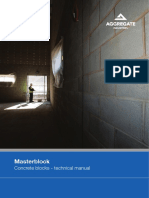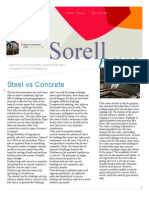0 ratings0% found this document useful (0 votes)
197 viewsKajima
Kajima
Uploaded by
bimo1. Kajima Corporation developed the "Cut and Take Down Method" for demolishing aging high-rise office buildings in a safe and environmentally friendly manner.
2. The method involves starting demolition from the bottom floor by cutting columns, lowering the entire building level-by-level using hydraulic jacks, and dismantling each floor safely at ground level rather than from the top down.
3. This allows for 90% recycling rates, minimal noise and safety risks, and takes less time than traditional demolition methods.
Copyright:
© All Rights Reserved
Available Formats
Download as PDF, TXT or read online from Scribd
Kajima
Kajima
Uploaded by
bimo0 ratings0% found this document useful (0 votes)
197 views4 pages1. Kajima Corporation developed the "Cut and Take Down Method" for demolishing aging high-rise office buildings in a safe and environmentally friendly manner.
2. The method involves starting demolition from the bottom floor by cutting columns, lowering the entire building level-by-level using hydraulic jacks, and dismantling each floor safely at ground level rather than from the top down.
3. This allows for 90% recycling rates, minimal noise and safety risks, and takes less time than traditional demolition methods.
Original Description:
one of the greatest demolition method
Copyright
© © All Rights Reserved
Available Formats
PDF, TXT or read online from Scribd
Share this document
Did you find this document useful?
Is this content inappropriate?
1. Kajima Corporation developed the "Cut and Take Down Method" for demolishing aging high-rise office buildings in a safe and environmentally friendly manner.
2. The method involves starting demolition from the bottom floor by cutting columns, lowering the entire building level-by-level using hydraulic jacks, and dismantling each floor safely at ground level rather than from the top down.
3. This allows for 90% recycling rates, minimal noise and safety risks, and takes less time than traditional demolition methods.
Copyright:
© All Rights Reserved
Available Formats
Download as PDF, TXT or read online from Scribd
Download as pdf or txt
0 ratings0% found this document useful (0 votes)
197 views4 pagesKajima
Kajima
Uploaded by
bimo1. Kajima Corporation developed the "Cut and Take Down Method" for demolishing aging high-rise office buildings in a safe and environmentally friendly manner.
2. The method involves starting demolition from the bottom floor by cutting columns, lowering the entire building level-by-level using hydraulic jacks, and dismantling each floor safely at ground level rather than from the top down.
3. This allows for 90% recycling rates, minimal noise and safety risks, and takes less time than traditional demolition methods.
Copyright:
© All Rights Reserved
Available Formats
Download as PDF, TXT or read online from Scribd
Download as pdf or txt
You are on page 1of 4
CTBUH Innovation Award
Finalist
Kajima Corporation Buildings Demolition Method
Tokyo, Japan
high-rise construction boom in Japan during
the 1960s and 70s has resulted in a large
amount of aging towers. Building owners
have an interest in demolishing the old structures
to replace them with more modern, safe, and workfriendly buildings, but there are several issues to
address in this process.
The Kajima Cut and Take Down Method was
developed to satisfy both safety and environmental
concerns. In April 2007, Kajima started to develop this
new demolition method to demolish its aging office
headquarters buildings which were 75 meters tall and
65 meters tall.
Buildings are usually demolished by placing heavy
equipment and workers on the top floor and then
lowering the waste material down to ground level. The
Cut and Take Down Method alternatively allows the
workers to start at the base and work their way up.
By starting at the bottom, gutting one floor, and then
lowering the entire building on jacks one floor at a
time, all work can be performed safely at ground level.
1. Cut the column. Cut length of 70 centimeters for a column and take off
column
jack
2. Extend the jack stroke. Extend length of 70 centimeters for jack stroke
3. Take down all jacks. After doing step 1 & 2 for all columns, all jacks were
taken down
4. Take out beams and floor slab of the floor above
Completion Date: Tower 1: 1968; Tower 2: 1972
Demolition Date: Tower 1: 2008; Tower 2: 2005
Height: Tower 1: 76 m (249 ft), Tower 2: 65 m (213 ft)
Stories: Tower 1: 20, Tower 2: 17
Area: Tower 1: 12,180 sq m (131,100 sq ft); Tower 2: 16,710 sq m
(179,865 sq ft)
Primary Use: Oce
Owner/ Developer: Kajima Corporation
Design Architect: Kajima Corporation
Structural Engineer: Kajima Corporation
MEP Engineer: Kajima Corporation
Main Contractor: Kajima Corporation
demolition
Above: Demolition Process
Opposite: Aerial view of the buildings
before demolition (top), view of the
buildings after demolition has nearly
completed (bottom)
182
183
Left: Demolition process underway
Opposite Left: Temporary support
columns
Opposite Right: Cutting and
removing columns
There are so many quiet revolutions going on
in tall buildings. Top-Down construction is one
such revolution and here is anotherBottom-Up
Demolition.
Antony Wood, Juror, CTBUH
On the 85 by 60 meter site, the two towers were
situated quite close to another office building and a
residential building, emphasizing the need for a clean,
quiet demolition process. To accomplish this, temporary columns are used around the structural column
grid, the existing columns are replaced, and then
hydraulic jacks are placed where the existing columns
were and the building can be lowered to the next floor
plate where the process is repeated.
The hydraulic jacks each had a capacity of 1,200 tons,
and supported the structure through each cycle of
lowering. A cycle would lower the whole building by
675 mm, which meant that five cycles were required
for each floor (total of 3.375 meters). The total time
to demolish a whole floor was six days: 2.5 days for
lowering and the remaining time to demolish the rest
of the structure.
A Core Wall and Load Transferring Frame system
are utilized to temporarily reinforce the structure
to prevent any lateral movements due to wind or
earthquake forces. The Core Wall was 400900 mm
thick reinforced concrete and was placed in the center
of the floor plates up to the third level to take any
lateral forces of the superstructure. To ensure the
transfer of lateral loads, the Load Transferring Frame
was installed in steel and connected to the existing
structure. It was then tied into the Core Wall with a
track-like system, which would lock in place in the
event of an earthquake.
The new method allows the dismantled building to
keep the same level of seismic and wind resistance
capability as its original design. It also reduces the
amount of noise as compared with typical top-down
approaches, because all the work is being completed at
the ground level. Safety of workers is increased as well,
184
due to the location of all the work being at ground
level as opposed to the building top.
In considering the reduction of site waste being sent to
landfills, this new method allows for a more efficient
system of recycling and reusing. The orderliness of
the process means that the materials from each floor
may be sorted effectively so the maximum amount of
material is sent to its rightful place instead of batches
of material getting sent to the landfill without adequate
sorting. The Kajima Towers were able to be sorted
into 30 types of materials for recycling, as opposed to
a typical 20 at other demolition sites. The recycling
rate was over 90% for the interiors of the buildings,
surpassing the average 55%.
Although this method was developed for a building
with steel frame structure up to 20 stories high, it can
be applied to larger scale buildings as well. Further-
185
more, this process is especially useful in densely-built
areas where typical demolition may impact neighboring buildings. The demolition of the two Kajima
Towers was completed in nine months for the 20 and
17 story buildings. Though the costs of this method
may be 510% higher than traditional methods, the
total time of demolition can be decreased by 15%,
increasing the turnover rate of the site.
Jury Statement
The demolition of older tall buildings is increasingly
becoming an issue with the impact on the environment
and re-use of materials. The new Kajima method oers
a solution which addresses and improves upon typical
demolition methods. This method will improve the
sustainability of a building through its lifespan and nal
deconstruction. Aside from improving sustainability, this
method also decreases the impact of demolition on its
surroundings.
You might also like
- Prestressed DWallDocument4 pagesPrestressed DWallTimotei VasileNo ratings yet
- FNCPDocument3 pagesFNCPLander VirayNo ratings yet
- Assignment 4 Weatherproofing - 2021Document4 pagesAssignment 4 Weatherproofing - 2021Nisha PrakashNo ratings yet
- Review of Design and Installation PracticesDocument82 pagesReview of Design and Installation Practicestimur sibaevNo ratings yet
- Build 141 Bracing SupplementDocument36 pagesBuild 141 Bracing SupplementRajeev SharanNo ratings yet
- Learning London: The Shard Story - Developing The ShardDocument13 pagesLearning London: The Shard Story - Developing The ShardJohn JonesNo ratings yet
- BU438 BRANZ Using A Scala PenetrometerDocument5 pagesBU438 BRANZ Using A Scala PenetrometerpohopetchNo ratings yet
- Enclosure Mansonry Wall Systems WorldwideDocument229 pagesEnclosure Mansonry Wall Systems Worldwidexxxxx8086No ratings yet
- High Performance Buildings: Using Tunnel Form Concrete ConstructionDocument8 pagesHigh Performance Buildings: Using Tunnel Form Concrete ConstructionDawit SolomonNo ratings yet
- Msds Rheomax DR 1030 enDocument9 pagesMsds Rheomax DR 1030 enBuenaventura Jose Huamani TalaveranoNo ratings yet
- Ewt 655 WNDocument28 pagesEwt 655 WNMuhammad RafkiNo ratings yet
- Final Batangas City Zoning Ordinance PDFDocument139 pagesFinal Batangas City Zoning Ordinance PDFPauline100% (1)
- One Bryant Park - PPTDocument28 pagesOne Bryant Park - PPTYamNo ratings yet
- MS - SikaWrap-231 C (Structural Strenghtening) (v.01.2018)Document5 pagesMS - SikaWrap-231 C (Structural Strenghtening) (v.01.2018)abdillah mursyidNo ratings yet
- Joint SealantsDocument4 pagesJoint SealantsBudiawan BudtseNo ratings yet
- MS SikaWrap FX - Penetrating Full SectionDocument20 pagesMS SikaWrap FX - Penetrating Full SectiontenNo ratings yet
- GE-1 Weights Building MaterialsDocument2 pagesGE-1 Weights Building Materialsreset00No ratings yet
- Notes On Hy-RibDocument20 pagesNotes On Hy-RibMohd Faizal100% (1)
- Product Catalogue: Rawlplug LTDDocument154 pagesProduct Catalogue: Rawlplug LTDhemendraengNo ratings yet
- Masterblock: Concrete Blocks - Technical ManualDocument38 pagesMasterblock: Concrete Blocks - Technical ManualdamindaNo ratings yet
- Chapter 1-5Document46 pagesChapter 1-5Dan Warren Loyola NuestroNo ratings yet
- Underpinning Solutions of Historical Constructions PDFDocument10 pagesUnderpinning Solutions of Historical Constructions PDFRose Carla GuerrierNo ratings yet
- UAC Fixing Manual NewDocument16 pagesUAC Fixing Manual Newmosaic09No ratings yet
- BAMTEC Detailing ManualDocument21 pagesBAMTEC Detailing Manualmohanuma100% (1)
- Structural and Economic Benefits of Precast Prestressed Concrete ConstructionDocument9 pagesStructural and Economic Benefits of Precast Prestressed Concrete ConstructionC08vikram sawantNo ratings yet
- Ms Conc Block Masonry 01Document3 pagesMs Conc Block Masonry 01Engr Muhammad SohailNo ratings yet
- WTP 3043 Building Contruction Supervision IDocument10 pagesWTP 3043 Building Contruction Supervision IWan AnisNo ratings yet
- Underpinning Systems For Settled FoundationsDocument3 pagesUnderpinning Systems For Settled FoundationsNazirul FariqNo ratings yet
- 00abstract Book 2015 AGS SymposiumDocument28 pages00abstract Book 2015 AGS SymposiumkrainajackaNo ratings yet
- European Precast Concrete Factbook 2011 Final DraftDocument6 pagesEuropean Precast Concrete Factbook 2011 Final DraftKlark_KentNo ratings yet
- T1 - Structural Assessment and Design - Dec 2020Document17 pagesT1 - Structural Assessment and Design - Dec 2020Abdulrahman Alnashar0% (1)
- BuchananDocument8 pagesBuchananbintnNo ratings yet
- 2017 0227 BombaDocument11 pages2017 0227 BombaRoci TeohNo ratings yet
- Building Maintenance Units: AgendaDocument45 pagesBuilding Maintenance Units: AgendaRanjit SinghNo ratings yet
- SikaWrap Dry Application 2016 Technical Information Manual UKDocument15 pagesSikaWrap Dry Application 2016 Technical Information Manual UKIbrahim SahinNo ratings yet
- Ipenz Royalcommissioncanterbury2011Document70 pagesIpenz Royalcommissioncanterbury2011NIVETHANo ratings yet
- Steel Framing Metsec SystemDocument8 pagesSteel Framing Metsec Systemhlopes10No ratings yet
- Hot Rolled and Structural Steel Products: 98 EditionDocument45 pagesHot Rolled and Structural Steel Products: 98 EditionSuperFrankfknNo ratings yet
- Twinson Composite Decking InstallationDocument17 pagesTwinson Composite Decking InstallationpbrilhanteNo ratings yet
- Bou Stead 2012Document16 pagesBou Stead 2012huynhvanchauNo ratings yet
- Brochure Fischer FIS EM PlusDocument4 pagesBrochure Fischer FIS EM PlusDona Dwi SaputroNo ratings yet
- Application of Infrared Thermography Technique in Uilding Finish EvaluationDocument9 pagesApplication of Infrared Thermography Technique in Uilding Finish EvaluationNicolas De NadaiNo ratings yet
- Geotechnical Investigation and Engineering Recommendations Kipnuk Bulk Fuel and Powerplant Facility Kipnuk, AlaskaDocument51 pagesGeotechnical Investigation and Engineering Recommendations Kipnuk Bulk Fuel and Powerplant Facility Kipnuk, AlaskaSi Rerumpai LautNo ratings yet
- The BCA Made Simple Part 1Document2 pagesThe BCA Made Simple Part 1T WNo ratings yet
- Lysaght Smartdek - Jan 2019Document2 pagesLysaght Smartdek - Jan 2019Chai Weng KuakNo ratings yet
- Pre-Fabricated Punching Shear ReinfDocument4 pagesPre-Fabricated Punching Shear ReinfJose ManjooranNo ratings yet
- Heat Insulation Solar Glass and Application On Energy Efficiency BuildingsDocument13 pagesHeat Insulation Solar Glass and Application On Energy Efficiency BuildingsMochyNo ratings yet
- Andrew Way's Report (62470)Document51 pagesAndrew Way's Report (62470)bc.arquitectoNo ratings yet
- Haefele Pocket Doors2016!1!12Document12 pagesHaefele Pocket Doors2016!1!12JaimasaNo ratings yet
- Steel Vs Concrete StructureDocument2 pagesSteel Vs Concrete StructureDedy KristiantoNo ratings yet
- Concrete Surface Treatments - 2Document4 pagesConcrete Surface Treatments - 2derma_irmawanNo ratings yet
- ShoringDocument1 pageShoringSyerifaizal Hj. MustaphaNo ratings yet
- BuildingnCODE NTDocument89 pagesBuildingnCODE NTAnil PyakurelNo ratings yet
- w0014 Manual Ip CCVDocument5 pagesw0014 Manual Ip CCVchaymaa MRHARNo ratings yet
- 2008 Dahon User Manual enDocument32 pages2008 Dahon User Manual eninoblivionNo ratings yet
- PPVC Manufacturer Accreditation Scheme: Application FormDocument13 pagesPPVC Manufacturer Accreditation Scheme: Application FormNicky LimNo ratings yet
- Structural Health Monitoring of Underground Facilities - Technological Issues and ChallengesDocument14 pagesStructural Health Monitoring of Underground Facilities - Technological Issues and ChallengesAmar MistryNo ratings yet
- Failures That Changed Perception of Our Designs-InG IABSE December 14Document22 pagesFailures That Changed Perception of Our Designs-InG IABSE December 14Subramanian NarayananNo ratings yet
- Marco Full Product CatalogDocument54 pagesMarco Full Product Catalogjonathan1479No ratings yet
- Lifting Anchor BrochureDocument48 pagesLifting Anchor BrochureJacob ChirayilNo ratings yet
- Catalago Perfiles Americanos ArcelorDocument56 pagesCatalago Perfiles Americanos ArcelorGuillermoAlvarez84No ratings yet
- Construction Innovation and Process ImprovementFrom EverandConstruction Innovation and Process ImprovementAkintola AkintoyeNo ratings yet
- Structural Engineering DocumentsFrom EverandStructural Engineering DocumentsJorge de BritoNo ratings yet
- Construction InnovationFrom EverandConstruction InnovationFinn OrstavikNo ratings yet
- Material SelectionDocument3 pagesMaterial SelectionbimoNo ratings yet
- Example RACI DiagramDocument2 pagesExample RACI DiagrambimoNo ratings yet
- Value World Fall 2013Document49 pagesValue World Fall 2013bimoNo ratings yet
- Peran Total Quality Management Dalam Meningkatkan Daya Saing Di Era GlobalisasiDocument8 pagesPeran Total Quality Management Dalam Meningkatkan Daya Saing Di Era GlobalisasibimoNo ratings yet
- Backup of Spesific 2-V17Document1 pageBackup of Spesific 2-V17bimoNo ratings yet
- Output Balok 3.5Document81 pagesOutput Balok 3.5bimoNo ratings yet
- Solid Waste ManagementDocument2 pagesSolid Waste Management10Aboli MahajanNo ratings yet
- Five Nights at Freddys' LessonDocument3 pagesFive Nights at Freddys' Lessonpaula.mrtynNo ratings yet
- Application Form - Renovation WorkDocument2 pagesApplication Form - Renovation Workdmk.murthyNo ratings yet
- Clean Water Works - Volume 4Document32 pagesClean Water Works - Volume 4Northeast Ohio Regional Sewer DistrictNo ratings yet
- The Dangers of Cellulose Nitrate FilmDocument6 pagesThe Dangers of Cellulose Nitrate FilmRafister2k13No ratings yet
- 07 Koolhaas, JunkspaceDocument11 pages07 Koolhaas, Junkspacebecha18No ratings yet
- 2018 REDC Award BookletDocument136 pages2018 REDC Award Bookletrickmoriarty100% (1)
- Gigasept Instru Af ZSDB P GB enDocument6 pagesGigasept Instru Af ZSDB P GB enKadek Ayang Cendana PrahayuNo ratings yet
- Linta Joseph ProjectDocument4 pagesLinta Joseph ProjectLINTA JOSEPHNo ratings yet
- Material Safety Data Sheet: Effective Date 01.12.2011Document6 pagesMaterial Safety Data Sheet: Effective Date 01.12.2011JuanNo ratings yet
- Republic Act #9003Document33 pagesRepublic Act #9003Miguel Carlo TancangcoNo ratings yet
- Project Report: Employee Claim Reimbursement (Ecrs) Engineers India Limited (EIL)Document132 pagesProject Report: Employee Claim Reimbursement (Ecrs) Engineers India Limited (EIL)Ramesh Chandra Mishra0% (1)
- Investigatory ProjectDocument4 pagesInvestigatory ProjectJulien Patrick CebrianNo ratings yet
- Supply Base Report 2018 - v. 1.3Document32 pagesSupply Base Report 2018 - v. 1.3BioforestalNo ratings yet
- Composting OrganismsDocument22 pagesComposting OrganismsEka Praditya100% (1)
- GLAAS 2017 Report For Web - FinalDocument96 pagesGLAAS 2017 Report For Web - FinalNewsBharatiNo ratings yet
- Wavin As Product & Technical GuideDocument68 pagesWavin As Product & Technical GuideFerdika Arisandy YapariNo ratings yet
- Food Safety Program (Risk Management) PDFDocument11 pagesFood Safety Program (Risk Management) PDFMichael Dej Pablo100% (1)
- Technical & Safety Information - Commtest BATT0206: Specifications Cell PackDocument11 pagesTechnical & Safety Information - Commtest BATT0206: Specifications Cell PackMuhammad Fahmmi Bin MahmudNo ratings yet
- Alumnat: Eso 1, 2 I 3Document13 pagesAlumnat: Eso 1, 2 I 3RosaNo ratings yet
- June 2014 QP - Unit 1 Edexcel Chemistry A-LevelDocument26 pagesJune 2014 QP - Unit 1 Edexcel Chemistry A-LevelNabindra RuwaliNo ratings yet
- Lesson Guide in Earth and Life Science I. ObjectivesDocument3 pagesLesson Guide in Earth and Life Science I. Objectivesallanrnmanaloto100% (1)
- Thesis PDFDocument77 pagesThesis PDFsunny gautam100% (3)
- Practice Test Unit 6 and Unit 7Document6 pagesPractice Test Unit 6 and Unit 7YuukiNo ratings yet
- 022 Working at Height PTW,-1Document1 page022 Working at Height PTW,-1Hafiz NurahimNo ratings yet































































































